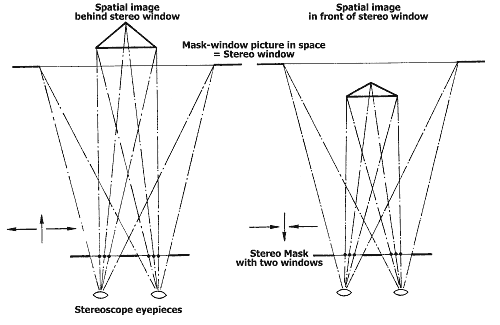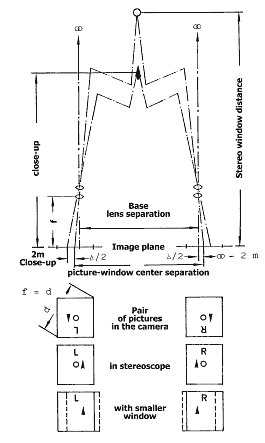


| 3. GENERAL REQUIREMENTS FOR THE STEREO PICTURE |
| 3.1 Out-of-focus photographs are unacceptable |
Every person endeavors to see objects as clearly as posssible, otherwise he feels uneasy. For this reason many people wear glasses. Our eyes are able to focus on distances greater than 25 cm. For closer distances, a magnifying glass is needed.
The eyes must not only accommodate, but also converge, i.e., the eye's axes must shift toward the object. Looking cross-eyed is a false or artificial form of convergence.
Even the softest or most blurred photographs or graphics are "clearly" seen, because the eyes are focused on the structure of the paper or on the raster in the print.
During stereoscopic viewing, the brain must not only focus, but must also blend or fuse the two images on the retinas into a spatial image. This causes headaches when the pictures are out-of-focus. The sharp lines needed to focus upon are missing.
First Stereo Rule: All pictures must be sharp from front to back.
Put into photographic terms this means that the depth of field must be made as large as possible by utilizing smaller apertures. The working aperture is usually at least 5.6, or better yet 8 or 11.
Accommodation is not a factor when viewing
stereo photographs since all of the picture's points lie in one plane.
| 3.2 Correct picture positioning |
In chapter 1 we learned that the stereoscopic impression is created by the somewhat different retina images. The emphasis lies on the word "somewhat". Therefore, we can not only present the eyes two different pictures of the same object when viewing a stereo picture. The difference between the two single views must conform to certain rules that stem from the physiology of the eyes. Some people are able to look cross-eyed "like a flounder", but this is only a horizontal shift of the eye's axes. Looking cross-eyed in a vertical direction is not possible. If the eyes are forced to focus in this manner headaches results. From this follows: Second Stereo Rule: In the picture there is to be no vertical parallax. Identical points in the single views must always lie on the same horizontal. Therefore, no single view may lie crooked in respect to the other!! !.
Consequently, the small difference between the two retina images occurs only from horizontal deviations. They lie in the so-called panum area of the eyes. The size of this area differs from person to person, as does the separation of the eyes. For this reason there are no set requirements to fulfill. If one does not wish to view one's stereo pictures only by oneself, but also proudly presents them to one's friends, one should voluntarily follow certain rules. The pictures should be of a standardized format (compatible), especially if one wants to participate in 3-D slide competitions.
When viewing framed stereo pictures in a stereoscope, the viewed objects lie in different planes. One of these is created by the frames of the picture. This is either caused by the inside edge of the slide frame, or by the usually white border of the paper pictures. While viewing, this border creates a sort of window, the so-called stereo window. It is often desired and in contests even required that the entire picture appears as lying behind the window. This then constitutes the Third Stereo Rule.
By shifting the single views in the horizontal
direction, the spatial image can be moved in front of, or in back of the
stereo window. A large separation between the single views moves the spatial
image back, whereas a smaller separation moves it forward. With this, a
decrease or increase in picture size occurs, as can be seen in figure 3.1.

|
|
|
Most of the exposures may be taken at a distance between 2 m and infinity. One should simply accept 2 m as the stereo window distance.
The separation of the centers of the picture windows
in the camera is usually larger than the lens separation by a length of ![]() (delta = deviation). Full use of the format is then achieved when the spatial
image is moved to behind the stereo window. This shift in the picture window
is also denoted as a built-in stereo window (fig. 3.2).
(delta = deviation). Full use of the format is then achieved when the spatial
image is moved to behind the stereo window. This shift in the picture window
is also denoted as a built-in stereo window (fig. 3.2).

|
|
|
Since the separation of the eyes (normally
called: interpupillary distance) is very dissimilar in each person and
race (differing by as much as 20 mm from a separation of 50 mm to one of
70 mm), one has settled upon a measurement of 63.5 mm as the international
standard. The stereoscopes or viewers should also satisfy this requirement.
Variations in eye separation may be compensated for by a correspondingly
large diameter of the viewing lenses, or by an adjustable lens separation
on the stereoscope.
| Previous
Chapter: A Little History |
Contents |
Next
Chapter: Exposure Criteria for Stereo Photographs |
 |
|

| Back to the Services Page |
